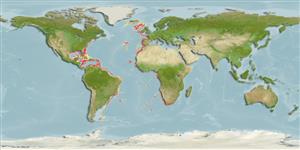Environment: milieu / climate zone / depth range / distribution range
Ecologia
marinhas batidemersal; intervalo de profundidade 550 - 1306 m (Ref. 9970). Deep-water
Atlantic Ocean: off Morocco, the Caribbean Sea, and off Nicaragua.
Tamanho / Peso / Idade
Maturity: Lm ? range ? - ? cm
Max length : 22.0 cm SL macho/indeterminado; (Ref. 4517)
Fin membranes dusky. Membranes lining roof of mouth and gill cavities dark except for light colored areas along branchiostegal membranes. General color, probably brown (Ref. 37108).
Life cycle and mating behavior
Maturidade | Reprodução | Desova | Ovos | Fecundidade | Larvas
Marshall, N.B., 1979. Macrouridae. p. 287-299. In J.C. Hureau and Th. Monod (eds.) Check-list of the fishes of the north-eastern Atlantic and of the Mediterranean (CLOFNAM). UNESCO, Paris. Vol. 1. (Ref. 9970)
Categoria na Lista Vermelha da IUCN (Ref. 130435: Version 2024-1)
Ameaça para o homem
Harmless
Utilização humana
Ferramentas
Relatórios especiais
Descarregue XML
Fontes da internet
Estimates based on models
Preferred temperature (Ref.
123201): 4.9 - 12, mean 7.4 °C (based on 139 cells).
Phylogenetic diversity index (Ref.
82804): PD
50 = 0.5001 [Uniqueness, from 0.5 = low to 2.0 = high].
Bayesian length-weight: a=0.00372 (0.00141 - 0.00976), b=3.11 (2.88 - 3.34), in cm total length, based on LWR estimates for this (Sub)family-body shape (Ref.
93245).
Nível Trófico (Ref.
69278): 3.0 ±0.00 se; based on food items.
Fishing Vulnerability (Ref.
59153): Low vulnerability (17 of 100).
